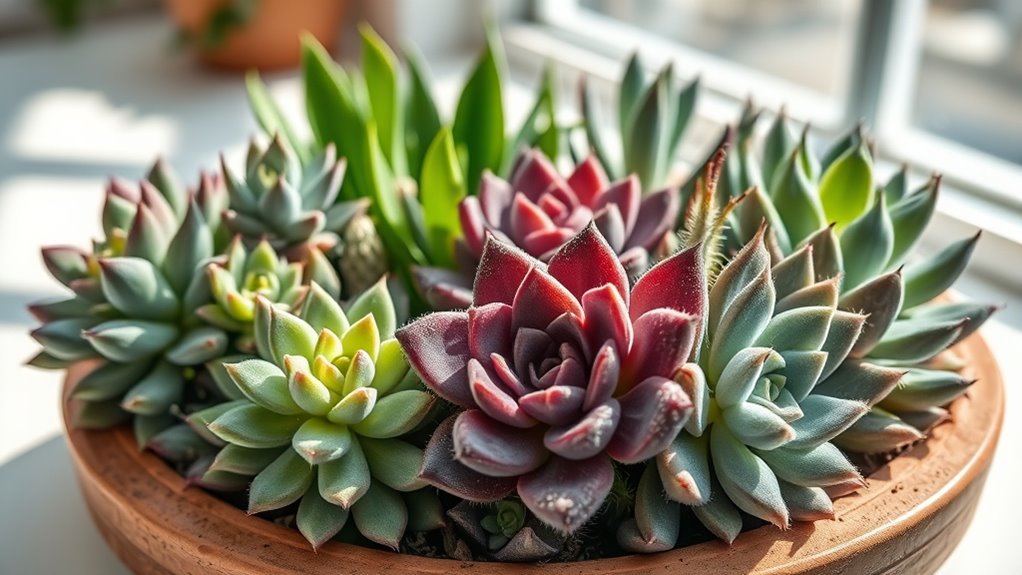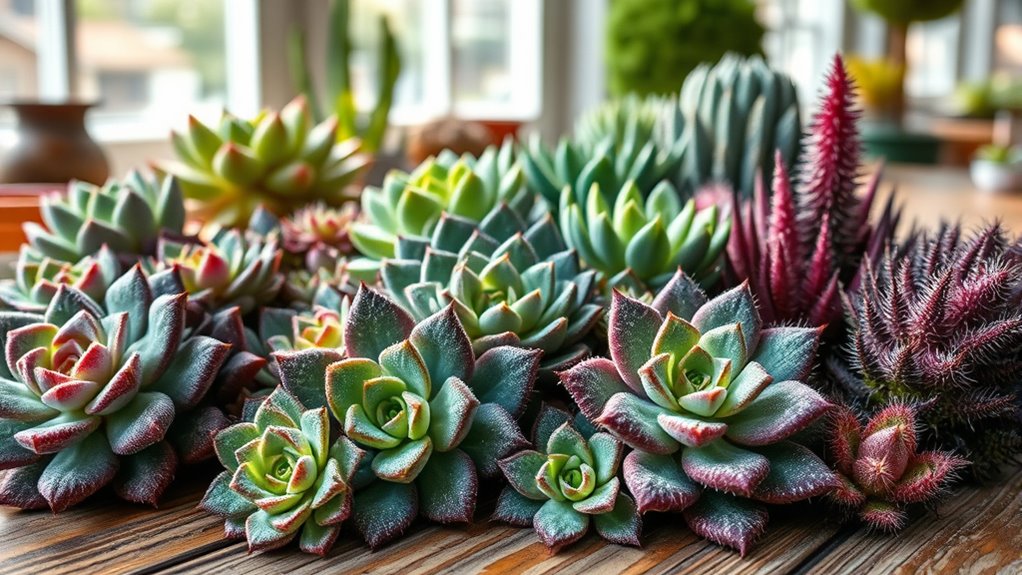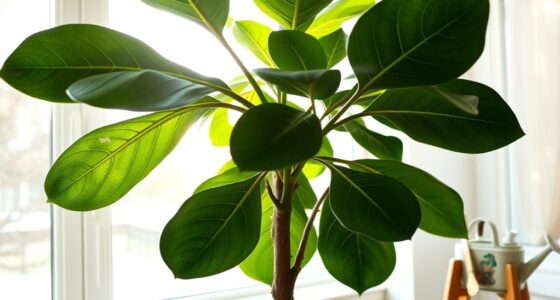To keep your succulents thriving, water them deeply but infrequently every 2-3 weeks, allowing the soil to dry out completely between waterings. Use well-draining soil and pots with drainage holes to prevent root rot. Provide bright, indirect sunlight and avoid overexposure. Regularly check soil moisture and water only when dry. With proper watering, soil, and light, you’ll help your desert plants stay healthy. Continue exploring these tips to master succulent care.
Key Takeaways
- Water succulents deeply every 2-3 weeks, allowing soil to dry completely between waterings.
- Use well-draining soil mixes with sand or perlite to prevent root rot.
- Ensure pots have drainage holes and remove excess water regularly.
- Provide bright, indirect sunlight to keep plants healthy and vibrant.
- Mimic desert conditions with proper watering, soil, and light for thriving succulents.

Are you wondering how to keep your succulents healthy and thriving? The key lies in understanding their unique watering needs and guaranteeing proper soil drainage. Succulents are desert plants that have adapted to survive in dry conditions, so overwatering is one of the biggest mistakes you can make. Establishing a consistent watering schedule is essential. Typically, you want to water deeply but infrequently—about once every two to three weeks, depending on your climate and the season. During the hotter months, you might need to water a little more often, while in cooler months, less frequent watering will suffice. Always check the soil first; if it’s still moist, wait a few more days before watering again. The goal is to let the soil dry out completely between waterings, mimicking their natural environment and preventing root rot.
Soil drainage plays an imperative role in succulent health. You should never plant succulents in heavy, clay-rich soil that retains water. Instead, opt for a well-draining cactus or succulent mix, or create your own by combining regular potting soil with coarse sand or perlite. This ensures excess water flows away quickly, preventing soggy roots and potential rot. When watering, make sure the water reaches the roots but doesn’t sit in the pot’s bottom. Using pots with drainage holes is essential—these allow excess water to escape and help maintain the right moisture balance. If you notice your succulents suddenly look droopy or their leaves become soft and mushy, it’s often a sign that they’re sitting in overly wet soil for too long.
Additionally, pay attention to the placement of your succulents. They love bright, indirect sunlight, which helps them thrive and retain their shape. If your plants start stretching out or losing their vibrant color, it might be a sign they’re not getting enough light, but overexposure can also cause stress. Proper watering combined with the right soil drainage setup creates the ideal environment for your succulents to flourish. Remember, these plants are resilient when cared for correctly, but they’re also very sensitive to overwatering and poor soil conditions. Keep a consistent watering schedule, guarantee excellent soil drainage, and provide ample light, and you’ll see your succulents grow healthy and strong, turning your indoor or outdoor space into a miniature desert paradise. Additionally, understanding their adaptation to dry environments can help you better mimic their natural habitat and improve their overall health.
Frequently Asked Questions
How Do I Propagate Succulents Successfully?
To propagate succulents successfully, start by choosing healthy cuttings or offsets. Use pruning techniques to trim healthy sections, allowing wounds to callus over for a few days. When watering, remember to reduce frequency to prevent rot—wait until the soil is dry before watering again. Plant the callused cuttings in well-draining soil, and place them in bright, indirect light. With patience, your succulents will root and thrive.
What Pests Commonly Infest Succulents?
Pests can turn your succulent oasis into a battlefield, making pest identification essential. Common culprits include mealybugs, spider mites, and scale insects. You can tackle these pests with natural remedies like neem oil or insecticidal soap, which are gentle yet effective. Regularly inspect your plants, and act swiftly to prevent infestations from spreading. Staying vigilant keeps your succulents healthy, vibrant, and pest-free—saving your garden from disaster!
Can Succulents Survive Indoors Without Sunlight?
You can keep succulents indoors without direct sunlight, but you need to provide adequate indoor lighting for their survival. While many succulents have a high shade tolerance, they still require bright, indirect light to thrive. Place them near a sunny window or use grow lights to mimic natural sunlight. Without sufficient indoor lighting, your succulents may become leggy or lose their vibrant color, so guarantee they get the right amount of light daily.
How Often Should I Repot My Succulents?
Did you know succulents grow slowly, often only needing repotting every 2-3 years? You should consider your watering schedule and pot size when repotting. Generally, repot your succulents when they outgrow their current container, usually indicated by roots coming out of drainage holes. Choose a slightly larger pot with good drainage, and wait until the soil is dry before repotting to minimize stress and overwatering risks.
What Soil Mix Is Best for Succulents?
For the best soil mix, you want one with excellent soil drainage and plenty of organic matter. Use a combination of coarse sand or perlite, potting soil, and some compost or organic matter to guarantee roots don’t sit in water. This mix keeps your succulents healthy by preventing root rot and providing necessary nutrients. Adjust the ratios based on your plant’s specific needs, but always prioritize good drainage and organic content.
Conclusion
By following these tips, your succulents will thrive, adding beauty and resilience to your space. Many believe succulents are nearly indestructible, but recent studies suggest they still need proper care to flourish. While their drought tolerance is impressive, overwatering and poor sunlight can still harm them. So, stay attentive to their needs, trust your instincts, and remember that even the hardiest plants require some nurturing. With patience and care, your desert plants will reward you with vibrant life.









